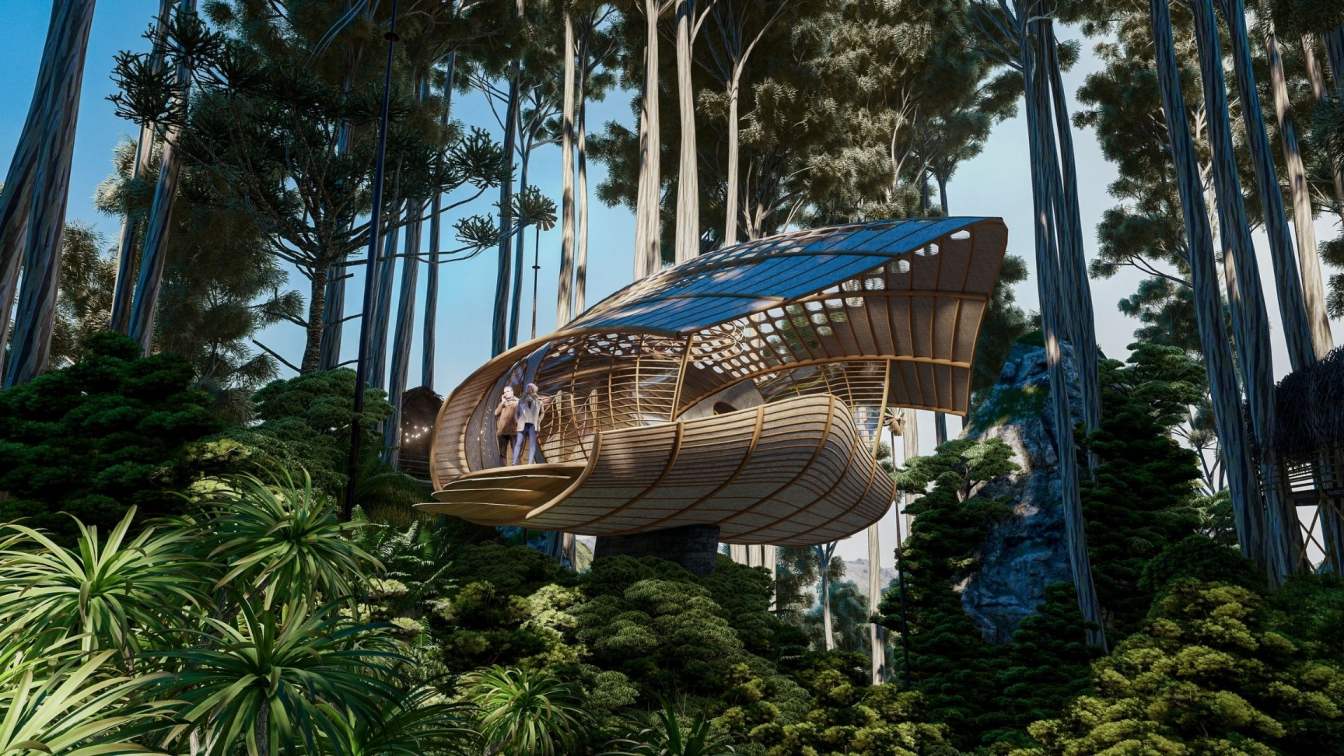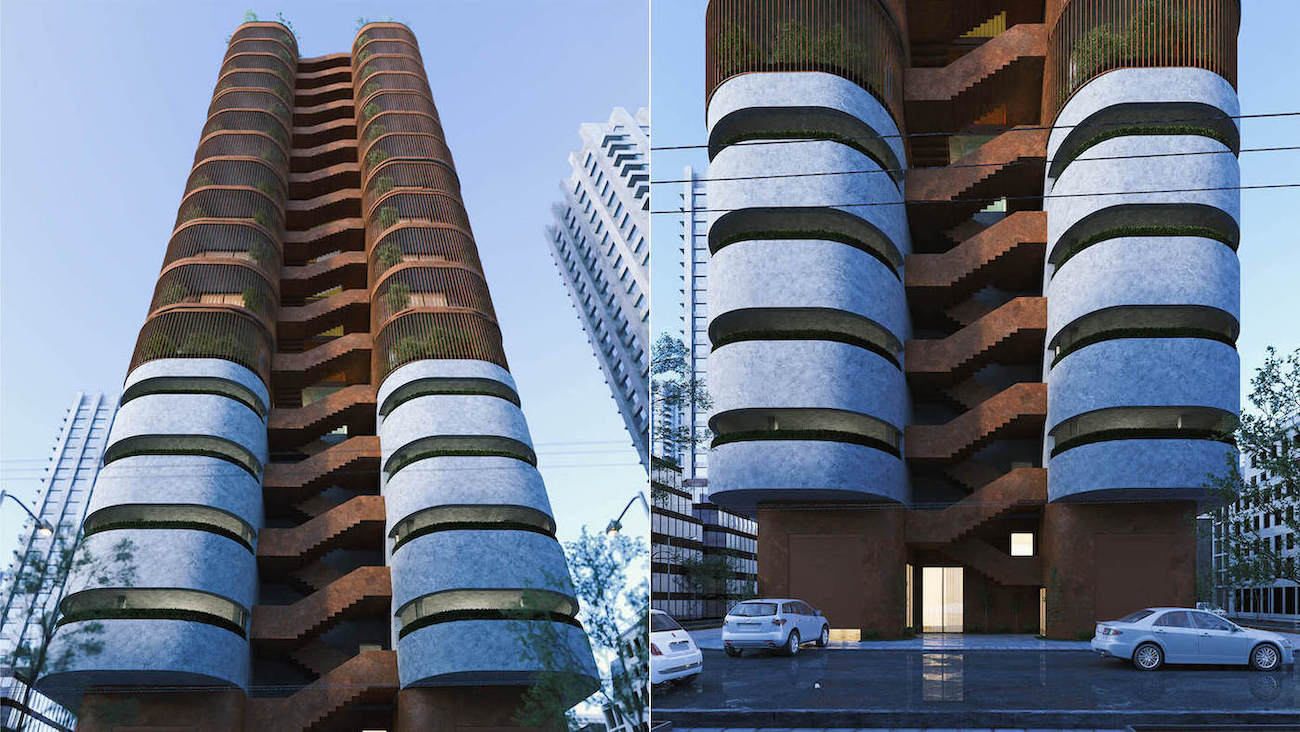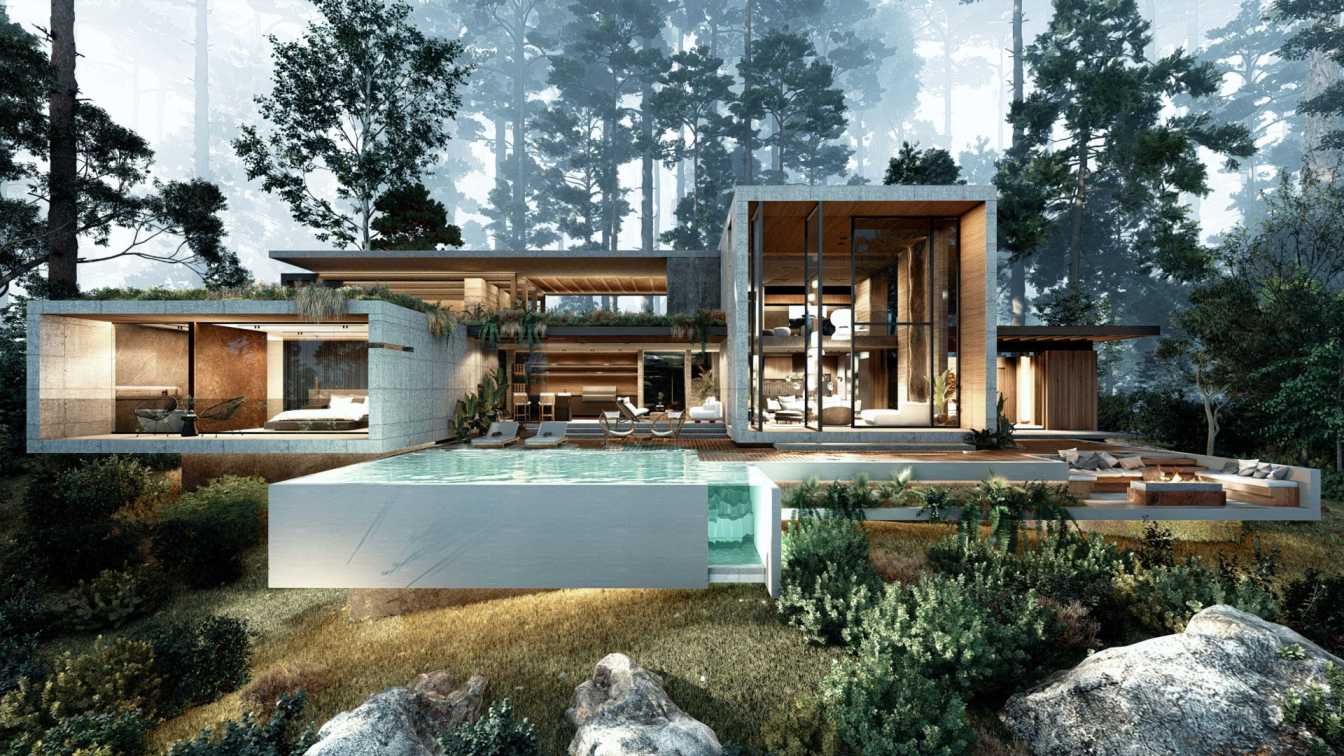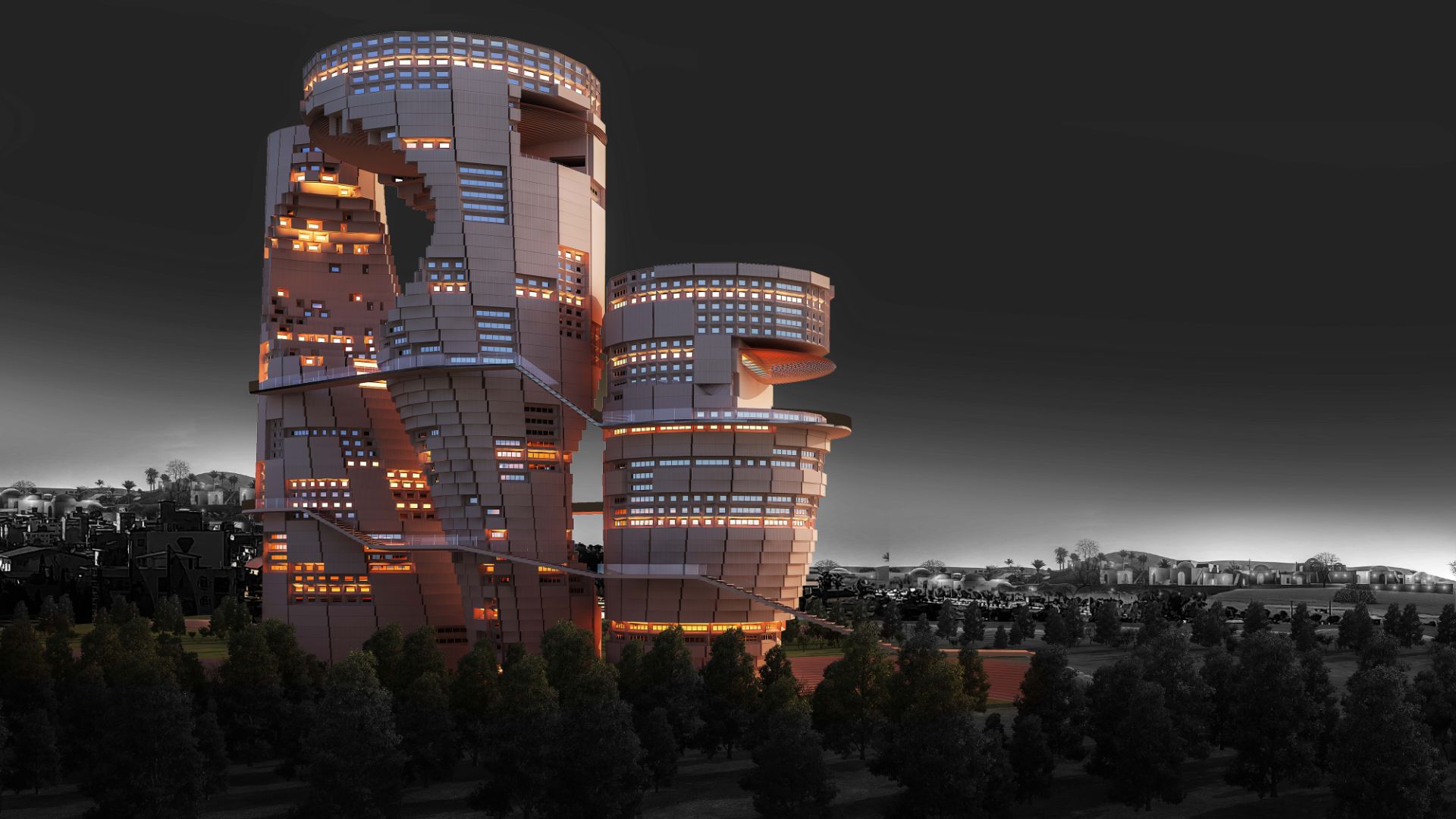“WHEN THE CITY TAKES CARE” THROUGH A NEW ECO-DISTRICT
Vincent Callebaut Architectures: HOSPIWOOD is a neologism composed of the Latin word "hospes" (which corresponds to the first syllable of the word hospital but also of hospitality) and the English word "wood", considered not only as the main biobased building material for the project (designed in CLT – Cross Laminated Timber) but also as an inhabited urban forest, green and blue matrix of a new eco-district in the making.
HOSPIWOOD challenges the traditional hospital model known as "Monospace" (care machine) to provide more humanistic and patient-centric healthcare to improve their experience during their stay in hospital and optimize their recovery time, while attracting and retaining the best healthcare professionals from Belgium and Europe in the City of La Louvière.
HOSPIWOOD reflects the noble ambition of the local hospital network to want to come together on the 14-hectare Longtain site by combining their respective skills within a single exemplary hospital campus in terms of sustainable development, agility of use and high-quality healthcare environment.
HOSPIWOOD creates a strong, architecturally emblematic hyphen between the Buset site (current Tivoli site) and the Longtain site along the new Boulevard Urbain de l'Est, a new structuring axis of the City of La Louvière wishing to accommodate a high mix of functions.

HOSPIWOOD articulates in the heart of an urban forest each building of the hospital campus as follows:
- “The Building K”: which is connected to the core of the “Tripod” of the Tivoli hospital and whose construction has just started.
- "The Ponte Vecchio": is an inhabited "bridge-building" which establishes the junction between the various medical staffs by integrating the restaurant, meeting rooms, administration offices and an amphitheater. It spans the avenue Max Buset to connect in a straight line (because it is quite simply the shortest way between two points) the K building and the new Longtain hospital in the form of a dynamic and spiral architecture, a true audacious symbol hospital partnership.
- "The Vertical Forest": is the new Longtain Hospital with 600 rooms spread over a program of 66,500 m² within a "medium height" building in L+6 on the eponymous site. Its architecture with soft curves, almost maternal, is a true vertical forest where one is treated in a biophilic atmosphere providing a feeling of well-being and serenity. Its circular base presents on the ground floor and L+1 a compact plan grouping the technical platforms around large patios, atrium, and gardens.
On the ground floor, the large admissions hall and the shops are integrated into the heart of a full-height flower-shaped atrium, while consultations, emergencies, imaging, radiotherapy, and dialysis are distributed in the 4 petals of the circular plane.
In L+1, intensive care, the interventional platform, endoscopies, ophthalmology and the day hospital follow the same spatial configuration.
The logistics basement is served by a peripheral circular moat which provides 360° functional management of flows, with little impact on the visual and sound levels for the additional functions of the campus.
Finally, from L+2 to L+6, four wings in the form of a quadripod accommodate 4 care units per floor, i.e. 12 surgery and medicine units (from L+2 to L+4) and 8 geriatrics units (from L+ 5 to L+6).
- “The Medical Logipole”: logistically serves the La Louvière site but also the other sites in the network (Nivelles, Lobbes, Mons, Warquignies). It is located on the northern roundabout side of Boulevard Urbain de l'Est for direct access from the road network (A-501 highway) and is linked by a glass footbridge to the new Longtain Hospital. This 10,000 m² logipole accommodates on 2 levels of 5000 m², punctuated by 3 patios, the central pharmacy stock, clean rooms, sterilization, and the central store.
- “The Campus”: brings together all the complementary functions (intergenerational co-living housing, nursing home, shops, sports halls, fablabs, craft workshops and coworking offices) which ensure urban diversity and are distributed within a masterplan ensuring on the one hand the strict alignment bordered by the Boulevard Urbain de l'Est, and on the other hand the permeability and influence of the site between rue de la Flache and rue de Longtain. Through all these places of local socio-economic activities, it is a question of integrating in a fair way an innovative reflection favoring "living together" based on well-being, respect, and solidarity.
HOSPIWOOD has the ambition to build a real eco-neighborhood where it is enjoying to live, work, have fun and above all seek medical treatment. From the scale of the territory to the "patient-centric" approach of the new hospital, the project aims to create a sustainable district consisting above all in imagining efficient and balanced management of flows as well as the use efficient local resources that make the most of the assets of the site and its environment and that make it possible to protect it.
To imagine, on the Longtain site, a new hospital campus of the 21st century for the City of La Louvière, is first of all to think about taking care of its territory and its landscape as well as its medical staff and its patients.

TAKE CARE OF YOUR TERRITORY
Taking care of your territory means wanting to embody the mining and steelmaking past of the City of La Louvière by writing the next lines of a story whose heart wants to continue beating by becoming a hospital center of excellence shining in Belgium and across Europe and the world.
Taking care of your territory means designing a resilient urban planning, able of synthesizing all the paths of ecological and solidarity transition, through the greening of the city and the repatriation of urban agriculture, the integration of renewable energies and the rules of climate-responsive design in buildings, the development of a transportation network dedicated to soft mobility or even low-carbon biobased construction.
The masterplan is part of a radiant urban planning where each building, road, and landscaped area are designed according to a radial and concentric plan. All the flows thus converge naturally towards the large atrium, the nerve center of the hospital campus, a new urban agora open to the public.
Constructing a "medium-rise" building also means appropriating the large landscape and magnifying the urban skyline punctuated by the huge three-bladed wind turbines bordering the “Canal du Centre” to the west of the site and by the heaps of mining residues from the old coal mines in ballast.
Taking care of your territory means combining the best of the industrial, cultural and natural heritage of the region to better feel “Louviérois”.

TAKE CARE OF YOUR LANDSCAPE
Taking care of your landscape means fighting against the artificialization of the soil. The leitmotif is to transform the fourteen hectares of the Longtain site, which once housed the old metallurgical rolling mills, into a veritable lush urban forest, densely planted with endemic trees, welcoming native biodiversity and harvesting rainwater through valleys creating islands of urban freshness.
All along the New “Boulevard Urbain de l’Est”, a huge tree-lined valley stretches over 450 meters long and 16 meters wide between the two new roundabouts that frame the Longtain site. At the lower edge of the relief, this valley is a phyto-purification pond recovering and filtering rainwater. This constitutes a water reservoir to irrigate the vegetated balconies of the Vertical Forest. It also provides a bucolic setting and tranquility for the inhabitants of the current Fayt trail.
The solar car parks, covered with photovoltaic canopies, are dedicated respectively to staff members, patients, visitors, and logistics flows. They are drawn as close as possible to the hospital in concentric bands that include large hedgerows, while the parking spaces are 50% covered with lawns ensuring draining soils. All the trees in the heart of the site are planted along these concentric bocage hedges.
The cemetery is isolated by a densely planted shrub border to embellish the East-West route between Avenue Max Buset and Rue de la Flache.
The pedestrian forecourt of the hospital is marked by a mineral continuity in local blue stone on the ground on the Boulevard Urbain de l'Est to better integrate bus stops, bicycle parking lots and encourage motorists to slow down.
To the north of the boulevard, the rows of trees highlight the route of the boulevard and reinforce the linear continuity of the buildings.
All new sidewalks are permeable and 50% planted. They make ample room for cycle paths which serve all the complementary functions of the campus.
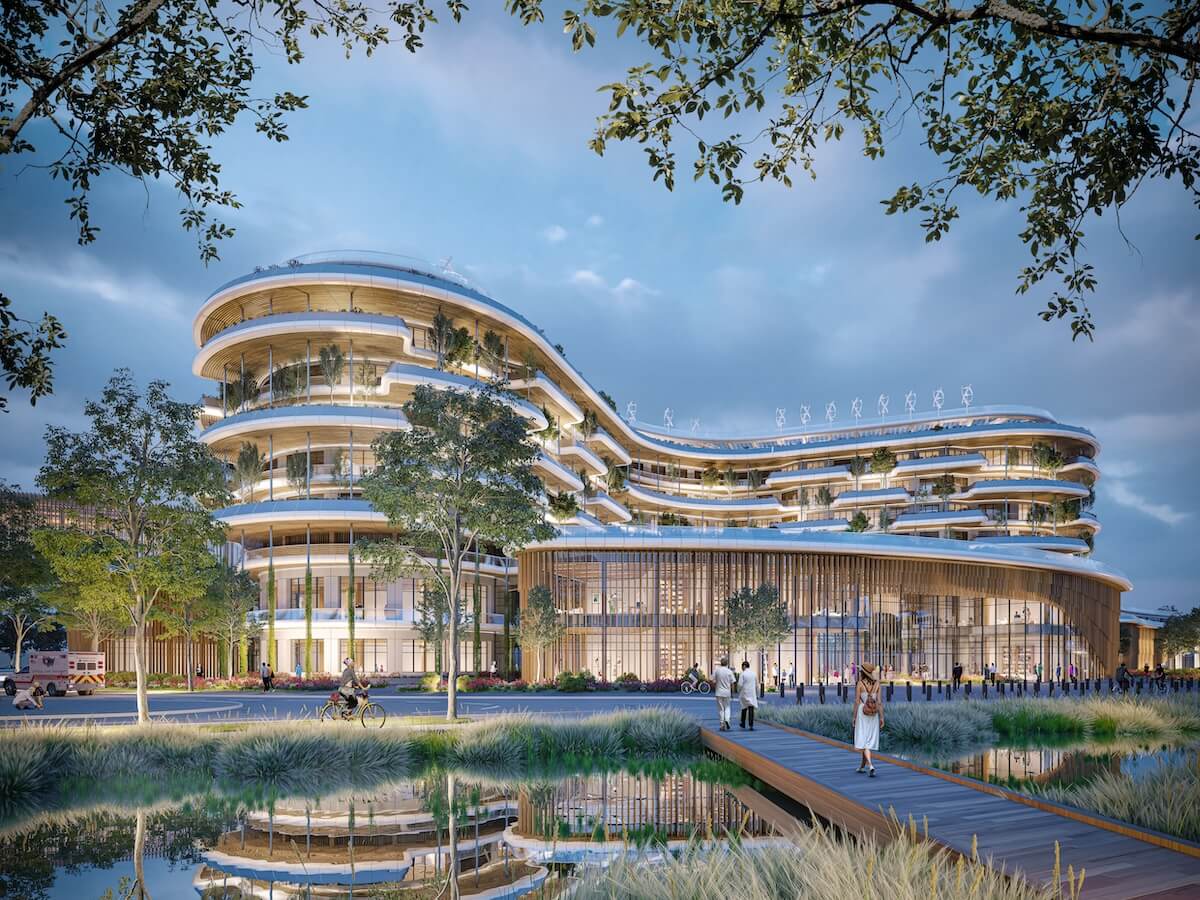
But the landscape is not only horizontal, it is also vertical. In addition to the trees in the ground planted in the urban forest, all the roofs of the eco-district are vegetated, like the new hospital, which has a fabulous rooftop medicinal garden, and urban market gardening cultivated in permaculture and aquaponics. This garden is shared with caregivers and patients who so wish.
The medicinal garden is sheltered by a photovoltaic and thermal solar canopy of 5250 m² producing electricity and domestic hot water redistributed in short circuit in the rooms of the patients while in the basement of the building, a network of geothermal probes is installed to ensure the winter and summer comfort of the entire building. A second solar canopy of 2100 m² also covers the logipole. The Longtain Hospital thus totals 7,350 m² of solar roofs.
On the facade, more than 2.5 kilometers of planters line in front of the bay windows of the rooms of the care units to offer each hospitalized patient a soothing plant environment from their bed. These planters are connected by rain chains that stage the descent of rainwater from the rooftop medicinal garden to the valleys.
More than 20,000 plants, shrubs and trees grow in this vertical forest, which captures up to 120 tons of CO2 per year from the atmosphere through natural photosynthesis. The evapotranspiration of the plants also makes it possible to bioclimatize all the facades and thus improve the comfort of the patients, especially in summer, by lowering the temperature between 3 and 5 degrees.

TAKE CARE OF YOUR CITIZENS
Taking care of your citizens means imagining the hospital campus of the future as a permeable place of destination that connects the neighborhoods that surround it. The new hospital must not be an introverted and anxiety-provoking fortress, it wants to be open to the public and porous to the urban flows that cross it.
A public route is made possible from West to East, from rue de la Flache to avenue Max Buset, crossing the hospital, its gardens, its shops and its fabulous 35-metre-high atrium.
Taking care of your fellow citizens means offering them a range of possibilities, opportunities to come and enjoy, at the heart of this campus, intergenerational housing in coliving, professional activities in coworking or sports leisure.
These additional facilities create the urban framework and strictly frame the Boulevard Urbain de l’Est, while offering large visual openings towards the interiors of the blocks.
To the west of the site, the campus is organized in radiating buildings connected by a curved gallery, a real bioclimatic interior street initiated on rue de la Flache and leading to rue Henri Pilette to the north.
All these ecological architectures built in engineered solid wood benefit from large cascading terraces and are spread out from L+1 to L+3 to blend perfectly into the urban fabric of the City of La Louvière, consisting mainly of terraced brick houses in L+1+Attic.

TAKE CARE OF YOUR MEDICAL STAFF
Taking care of its medical staff means compacting the operational performance of this new hospital by structuring them around porous and open places of conviviality between the departments, bathed in light, naturally ventilated, and built from biobased, recycled and/or or recyclable.
All the nursing stations, all the offices, all the consultation rooms thus benefit from bay windows on the first day and views towards interior gardens dedicated to conviviality. No horizontal or vertical circulation is blind to be everywhere connected to others, to the climate and to nature.
Finally, the "Ponte Vecchio" is a wooden masterpiece of architecture shared with the nursing staff of the hospitals on the Buset and Longtain sites. It concentrates the living forces of this partnership in a 180° spiral geometry offering them all the spaces to sustain themselves, meet and discuss while admiring the city spread out before their eyes.
Thus, through its spatial design, HOSPIWOOD promotes collaboration between different departments by integrating social spaces that promote chance encounters and the sharing of knowledge between staff as well as the provision of dedicated spaces for research and learning.

TAKE CARE OF YOUR PATIENTS
Taking care of your patients, offering them the most sensitive of hospitality, means designing the architecture of the hospital around their medical experience, but also based on their fear, their experience, their feelings.
Numerous studies suggest that access to and view of green spaces and contact with natural materials improve recovery times and contribute to better clinical outcomes for patients, while providing a more comfortable workplace for the patient. medical staff.
The building is thus surrounded by a rich landscape and flooded with natural light. Its architecture made entirely of bio-based and geo-based materials also offers patients an intimate and domestic scale allowing them to feel "like at home" and to be better connected with the surrounding urban forest while maximizing inter-connectivity for staff. in order to create a transdisciplinary working environment.
HOSPIWOOD pushes the boundaries of innovation in healthcare. It incorporates the latest technological innovations and patient-centered care in a flexible building that is immersed in nature. Its atrium, patios and gardens provide intuitive orientation and reduce travel times for patients, staff and visitors.
The analysis of sober approaches and innovative solutions was carried out in order to identify the right balance in the choices between "Low-Tech" and "High-Tech" solutions. The building's structural framework of 8m10 by 4m05 and its finished heights of 5m50 for the technical platforms and 3m80 for the care units lend themselves to modular and flexible planning.
Let us not forget that the sustainability of a building lies above all in the intelligence of its spatial design to make it reversible at will and adaptable to developments in future technologies and the inherent needs of future health crises. Thus, the functions and spaces that are assigned to each service are interchangeable, which allows a very high scalability to adapt to future changes.
Originally from the city of La Louvière, this project is particularly close to the heart of the architect Vincent Callebaut, and it is with emotion that his team designed this biophilic hospital in between 2021 and 2023 for the Groupe Jolimont Association.





